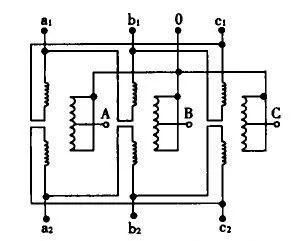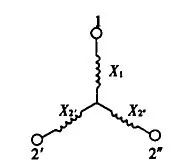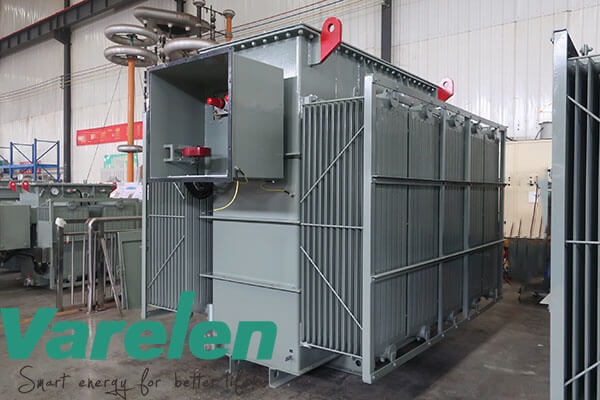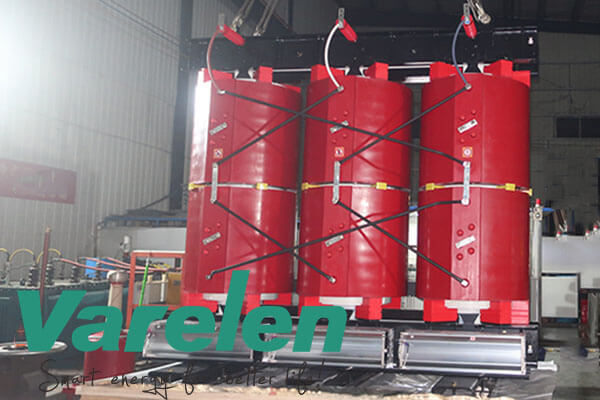Split winding transformer refers to a multi-winding power transformer composed of one high-voltage winding and two or more low-voltage winding with the same voltage and capacity. The normal power transmission of the split transformer is only carried out between the high and low voltage windings, and it has the effect of limiting the short circuit current when the fault occurs. Several branches have the same capacity, equal or close rated voltage, can operate separately or in parallel, and can bear the same or different loads. When the load or power supply connected to one low-voltage winding fails, the other low-voltage winding can still operate normally. There is no electrical connection between the split windings, and the magnetic coupling is relatively weak. There should be a large impedance between the split branches, and the same impedance between the split and non-split windings.
1. split transformer of oil immersed transformer
2. dry type split transformer
Three, the characteristics of the split transformer
In a transformer, the low-voltage coil is split into two or more parts of equal rated capacity. There is no electrical connection between the split coils, and only a weak magnetic connection.
Each branch of the split winding can run separately, or can run in parallel at the same rated voltage. After the low-voltage coil splits, the short-circuit impedance between the high-voltage coil and the split part of the low-voltage coil can be greatly increased, and the short-circuit impedance between the low-voltage split coil can be well restricted, so the split transformer is widely used in the power system.
According to its structure, the difference between the split transformer and the ordinary transformer is only the low-voltage coil itself on the iron core column, the low-voltage coil of the split transformer is not in series or parallel, and the beginning and the terminal are respectively led out.

Four, the equivalent circuit of the split transformer
Three-phase winding double split transformer, because each phase can be regarded as 3 winding, its equivalent circuit can be expressed by the general star equivalent circuit.

Five, the special parameters of the split transformer
1. When several branches of the split winding are connected in parallel to form a total low-voltage winding that operates against the high-voltage winding, it is called ride-through operation. At this time, the short-circuit impedance of the transformer is called ride-through impedance.
2. When a branch of the low-voltage split winding operates to the high-voltage winding, you operate as a half-crossover. At this time, the short-circuit impedance of the transformer is called half-crossover impedance.
3. When one branch of the split winding runs against the other branch, it is called split operation. At this time, the short-circuit impedance of the transformer is called split impedance.
4. The ratio of split impedance to crossover impedance is called split coefficient, which is one of the basic parameters of split transformer, generally 3-4.
5. Three-phase double-winding double-split transformer, each phase has three windings: a non-split high-voltage winding, which has two branches but is always connected in parallel and is actually one winding; two identical low-voltage split windings. Therefore, we can imitate the three-winding transformer and obtain an equivalent circuit composed of three equal impedances. Considering the symmetry of the branch arrangement of the split winding, the short-circuit impedance of each branch is equal, equal to one-half The splitting impedance is equal to one-half the splitting coefficient times the crossing impedance.
Six, the operation characteristics of the split transformer
Since the split transformer has a large reactance, large-unit power plants use split transformers as factory transformers and starting transformers, which have the following advantages in operation:
(1) Limit short-circuit current significantly. When one branch of the split winding is short-circuited, the short-circuit current supplied by the power grid through the semi-crossover reactance of the split transformer is larger than the ride-through reactance, so the short-circuit current supplied is smaller than that of the two-winding transformer. At the same time, the other branch of the split winding is short-circuited by the motor. The feedback current at the point is also reduced a lot due to the limitation of the split winding. This ensures the short-circuit stability of the electrical equipment on the factory bus.
(2) When one branch of the split winding fails, the bus voltage of the other branch decreases relatively little. At the same time, when the motor of one branch of the split winding starts automatically, the voltage of the other branch is almost unaffected. This improves the reliability of half the load supplied by the factory bus.
From installation and flexibility in retrofitting to their space-saving design and enhanced safety features, split transformers deliver efficiency, reliability, and cost-effectiveness. As electrical systems continue to evolve, split transformers remain a versatile solution for meeting the demands of modern infrastructure.



